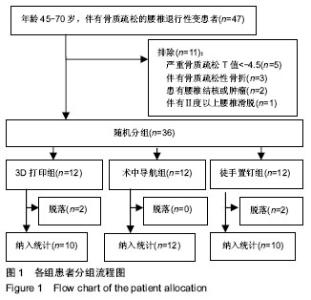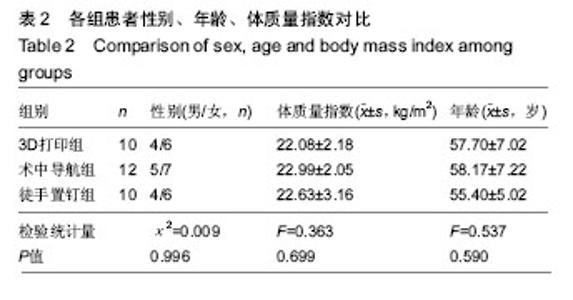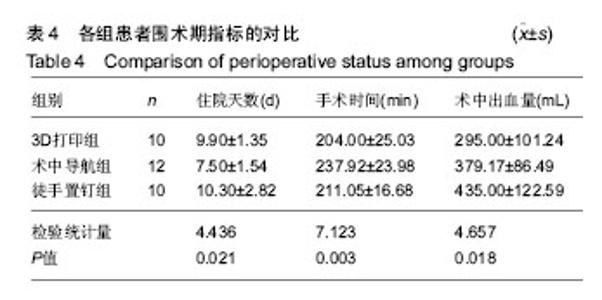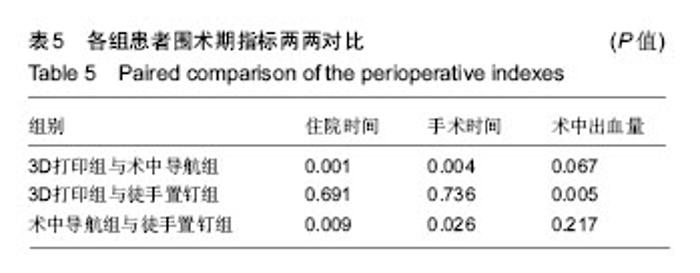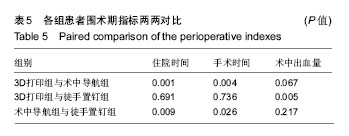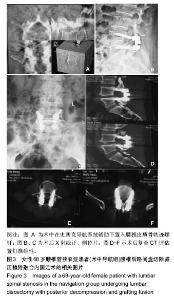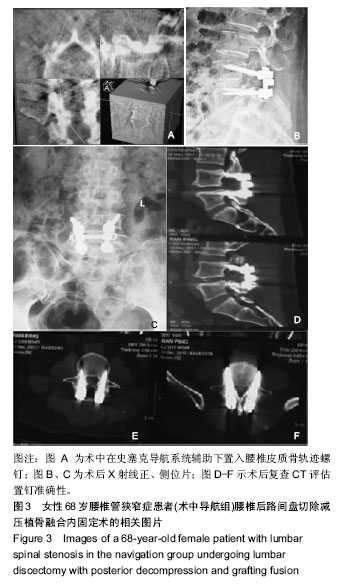Chinese Journal of Tissue Engineering Research ›› 2019, Vol. 23 ›› Issue (12): 1864-1869.doi: 10.3969/j.issn.2095-4344.1125
Previous Articles Next Articles
Accuracy and clinical efficacy of three-dimensional printing and navigation technology assisted lumbar cortical bone trajectory screw placement
Wang Xiji1, Zhang Yongyuan2, Yang Ruize2, Hao Dingjun2, Sun Honghui1
- 1Department of Orthopedics, Tangdu Hospital, the Military Medical University of Air Forces, Xi’an 710038, Shaanxi Province, China; 2Department of Spinal Surgery, Honghui Hospital, Xi’an Jiaotong University, Xi’an 710054, Shaanxi Province, China
-
Online:2019-04-28Published:2019-04-28 -
Contact:Sun Honghui, MD, Chief physician, Department of Orthopedics, Tangdu Hospital, the Military Medical University of Air Forces, Xi’an 710038, Shaanxi Province, China -
About author:Wang Xiji, Master candidate, Physician, Department of Orthopedics, Tangdu Hospital, the Military Medical University of Air Forces, Xi’an 710038, Shaanxi Province, China -
Supported by:the Major Research and Development Program of Shaanxi Province, No. 2017ZDXM-SF-054 (to HDJ)
CLC Number:
Cite this article
Wang Xiji, Zhang Yongyuan, Yang Ruize, Hao Dingjun, Sun Honghui. Accuracy and clinical efficacy of three-dimensional printing and navigation technology assisted lumbar cortical bone trajectory screw placement[J]. Chinese Journal of Tissue Engineering Research, 2019, 23(12): 1864-1869.
share this article
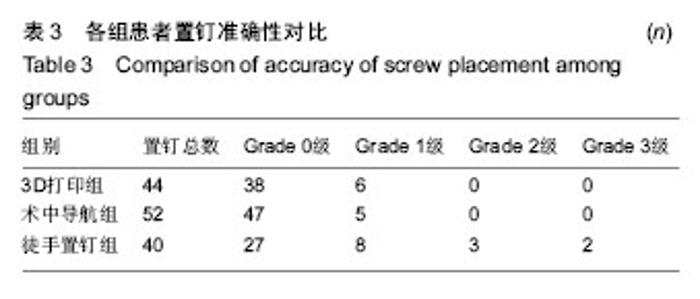
2.4 各组术后CT图像置钉Grade分级 各组患者均顺利完成手术。3D打印组共置入腰椎皮质骨轨迹螺钉44枚(L3 2枚,L4 18枚,L5 24枚),其中0级38枚(86.4%),1级6枚(13.6%),无2级或3级不良置钉;术中导航组共置入腰椎皮质骨轨迹螺钉52枚(L3 6枚,L4 20枚,L5 26枚),其中0级47枚(90.4%),1级5枚(9.6%),无2级或3级不良置钉;徒手置钉组共置入腰椎皮质骨轨迹螺钉40枚(L3 4枚,L4 16枚,L5 20枚),其中0级27枚(67.5%),1级8枚(20.0%),2级3枚(7.5%),3级2枚(5.0%)。3组间置钉精确性分级差异有显著性意义(P=0.010);3D打印组和导航组组间差异无显著性意义(P=0.540),2组均优于徒手置钉组(P=0.034;P=0.005),见表3。"
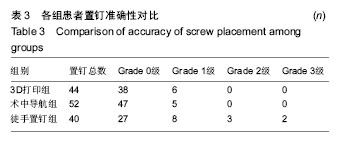
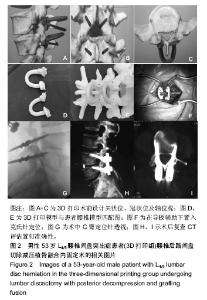
2.6 不良反应 徒手置钉组1例患者出现脑脊液漏,其余患者均无置钉相关的血管、神经并发症。所有患者术后随访均未出现螺钉松动移位及断裂情况。 2.7 植入物与宿主的生物相容性 3种植入物生物相容性良好,3组患者均未出现植入物周围感染、过敏反应、免疫反应及排斥反应。 2.8 可能影响结果的因素 ①3组间的置钉节段和病因分布不均,不同节段和病因对腰椎皮质骨轨迹螺钉置钉难度的影响不同,从而引起偏倚;②由于增生影响,3组患者间实际钉道骨质疏松程度无法评估,从而引起偏倚。 2.9 典型病例 典型病例1:男性患者,53岁,左下肢放散痛3个月余,术前诊断L4/5腰椎间盘突出症,入院后行腰椎后路间盘切除减压植骨融合内固定术,随访时间为术后1,3,6个月,未出现螺钉松动及移位,见图2。"
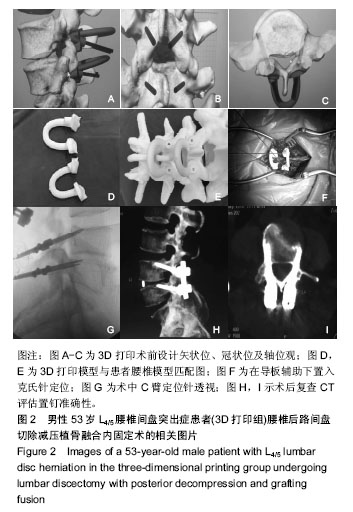
| [1] Wilcox B, Mobbs RJ, Wu A, et al. Systematic review of 3D printing in spinal surgery: The current state of play. J Spine Surg. 2017;3(3): 433-443.[2] Zhao Z, Liu Z, Hu Z, et al. Improved accuracy of screw implantation could decrease the incidence of post-operative hydrothorax? O-arm navigation vs. Free-hand in thoracic spinal deformity correction surgery. Int Orthop. 2018; 42(9): 2141-2146.[3] Cramer J, Quigley E, Hutchins T, et al. Educational material for 3D visualization of spine procedures: Methods for creation and dissemination. J Digit Imaging. 2017;30(3): 296-300.[4] Choy WJ, Mobbs RJ, Wilcox B, et al. Reconstruction of thoracic spine using a personalized 3D-Printed vertebral body in adolescent with t9 primary bone tumor. World Neurosurg. 2017;105:1013-1032.[5] Kojima K, Asamoto S, Kobayashi Y, et al. Cortical bone trajectory and traditional trajectory--a radiological evaluation of screw-bone contact. Acta Neurochir. 2015;157(7): 1173-1178.[6] Li HM, Zhang RJ, Gao H, et al. Biomechanical fixation properties of the cortical bone trajectory in the osteoporotic lumbar spine. World Neurosurg. 2018.[7] Lee GW, Ahn M. Comparative study of cortical bone Trajectory-Pedicle screw (Cortical screw) versus conventional pedicle screw in Single-Level posterior lumbar interbody fusion: A 2-Year post hoc analysis from prospectively randomized data. World Neurosurg. 2018;109:e194-e202.[8] Keorochana G, Pairuchvej S, Trathitephun W, et al. Comparative outcomes of cortical screw trajectory fixation and pedicle screw fixation in lumbar spinal fusion: Systematic review and meta-analysis. World Neurosurg. 2017;102:340-349.[9] Patel SS, Cheng WK, Danisa OA. Early complications after instrumentation of the lumbar spine using cortical bone trajectory technique. J Clin Neurosci. 2016;24:63-67.[10] Snyder LA, Martinez-Del-Campo E, Neal MT, et al. Lumbar spinal fixation with cortical bone trajectory pedicle screws in 79 patients with degenerative disease: Perioperative outcomes and complications. World Neurosurg. 2016;88:205-213.[11] Matsukawa K, Yato Y, Nemoto O, et al. Morphometric measurement of cortical bone trajectory for lumbar pedicle screw insertion using computed tomography. J Spinal Disord Tech. 2013; 26(6): E248-E253.[12] Kaito T, Matsukawa K, Abe Y, et al. Cortical pedicle screw placement in lumbar spinal surgery with a patient-matched targeting guide: A cadaveric study. J Orthop Sci. 2018.[13] Aoude AA, Fortin M, Figueiredo R, et al. Methods to determine pedicle screw placement accuracy in spine surgery: A systematic review. Eur Spine J. 2015;24(5): 990-1004.[14] Mobbs RJ. Differences in bone mineral density between cortical bone trajectory and traditional lumbar pedicle screws: Commentary. Spine J. 2016;16(7): 842.[15] Delgado-Fernandez J, García-Pallero MÁ, Blasco G, et al. Review of cortical bone trajectory: Evidence of a new technique. Asian Spine J. 2017; 11(5): 817.[16] Senoglu M, Karadag A, Kinali B, et al. Cortical bone trajectory screw for lumbar fixation: A quantitative anatomic and morphometric evaluation. World Neurosurg. 2017;103:694-701.[17] Kasukawa Y, Miyakoshi N, Hongo M, et al. Short-Term results of transforaminal lumbar interbody fusion using pedicle screw with cortical bone trajectory compared with conventional trajectory. Asian Spine J. 2015;9(3): 440.[18] Hussain I, Virk MS, Link TW, et al. Posterior lumbar interbody fusion with 3D-Navigation guided cortical bone trajectory screws for l4/5 degenerative spondylolisthesis: 1-Year clinical and radiographic outcomes. World Neurosurg. 2018;110:e504-e513.[19] Feng Z, Li X, Tang Q, et al. Transforaminal lumbar interbody fusion with cortical bone trajectory screws versus traditional pedicle screws fixation: A study protocol of randomised controlled trial. BMJ Open. 2017;7(10): e17227.[20] Cho W, Job AV, Chen J, et al. A review of current clinical applications of Three-Dimensional printing in spine surgery. Asian Spine J. 2018; 12(1): 171.[21] Sugawara T, Higashiyama N, Kaneyama S, et al. Accurate and simple screw insertion procedure with Patient-Specific screw guide templates for posterior C1-C2 fixation. Spine. 2017;42(6): E340-E346.[22] Wu HH, Su I, Hsieh C, et al. Accuracy and safety of using customized guiding templates for cervical pedicle screw insertion in severe cervical deformity, fracture, and subluxation: A retrospective study of 9 cases. World Neurosurg. 2018;116:e1144-e1152.[23] Bovonratwet P, Nelson SJ, Ondeck NT, et al. Comparison of Thirty-Day complications between navigated AndConventional Single-Level instrumented posterior lumbar fusion: A propensity score matched analysis. Spine. 2018.[24] Wei R, Guo W, Ji T, et al. One-step reconstruction with a 3D-printed, custom-made prosthesis after total en bloc sacrectomy: A technical note. Eur Spine J. 2017;26(7): 1902-1909.[25] Hussain I, Virk MS, Link TW, et al. Posterior lumbar interbody fusion with 3D-Navigation guided cortical bone trajectory screws for l4/5 degenerative spondylolisthesis: 1-Year clinical and radiographic outcomes. World Neurosurg. 2018; 110:e504-e513.[26] Rodriguez A, Neal MT, Liu A, et al. Novel placement of cortical bone trajectory screws in previously instrumented pedicles for adjacent- segment lumbar disease using CT image-guided navigation. Neurosurg Focus. 2014;36(3): E9.[27] Urbanski W, Jurasz W, Wolanczyk M, et al. Increased radiation but no benefits in pedicle screw accuracy with navigation versus a freehand technique in scoliosis surgery. Clin Orthop Relat R. 2018; 476(5): 1020-1027. |
| [1] | Zhang Tongtong, Wang Zhonghua, Wen Jie, Song Yuxin, Liu Lin. Application of three-dimensional printing model in surgical resection and reconstruction of cervical tumor [J]. Chinese Journal of Tissue Engineering Research, 2021, 25(9): 1335-1339. |
| [2] | Zhang Chao, Lü Xin. Heterotopic ossification after acetabular fracture fixation: risk factors, prevention and treatment progress [J]. Chinese Journal of Tissue Engineering Research, 2021, 25(9): 1434-1439. |
| [3] | Tang Hui, Yao Zhihao, Luo Daowen, Peng Shuanglin, Yang Shuanglin, Wang Lang, Xiao Jingang. High fat and high sugar diet combined with streptozotocin to establish a rat model of type 2 diabetic osteoporosis [J]. Chinese Journal of Tissue Engineering Research, 2021, 25(8): 1207-1211. |
| [4] | Li Zhongfeng, Chen Minghai, Fan Yinuo, Wei Qiushi, He Wei, Chen Zhenqiu. Mechanism of Yougui Yin for steroid-induced femoral head necrosis based on network pharmacology [J]. Chinese Journal of Tissue Engineering Research, 2021, 25(8): 1256-1263. |
| [5] | Zeng Yanhua, Hao Yanlei. In vitro culture and purification of Schwann cells: a systematic review [J]. Chinese Journal of Tissue Engineering Research, 2021, 25(7): 1135-1141. |
| [6] | Hou Guangyuan, Zhang Jixue, Zhang Zhijun, Meng Xianghui, Duan Wen, Gao Weilu. Bone cement pedicle screw fixation and fusion in the treatment of degenerative spinal disease with osteoporosis: one-year follow-up [J]. Chinese Journal of Tissue Engineering Research, 2021, 25(6): 878-883. |
| [7] | Song Chengjie, Chang Hengrui, Shi Mingxin, Meng Xianzhong. Research progress in biomechanical stability of lateral lumbar interbody fusion [J]. Chinese Journal of Tissue Engineering Research, 2021, 25(6): 923-928. |
| [8] | Li Shibin, Lai Yu, Zhou Yi, Liao Jianzhao, Zhang Xiaoyun, Zhang Xuan. Pathogenesis of hormonal osteonecrosis of the femoral head and the target effect of related signaling pathways [J]. Chinese Journal of Tissue Engineering Research, 2021, 25(6): 935-941. |
| [9] | Xiao Fangjun, Chen Shudong, Luan Jiyao, Hou Yu, He Kun, Lin Dingkun. An insight into the mechanism of Salvia miltiorrhiza intervention on osteoporosis based on network pharmacology [J]. Chinese Journal of Tissue Engineering Research, 2021, 25(5): 772-778. |
| [10] | Liu Bo, Chen Xianghe, Yang Kang, Yu Huilin, Lu Pengcheng. Mechanism of DNA methylation in exercise intervention for osteoporosis [J]. Chinese Journal of Tissue Engineering Research, 2021, 25(5): 791-797. |
| [11] | Xu Dongzi, Zhang Ting, Ouyang Zhaolian. The global competitive situation of cardiac tissue engineering based on patent analysis [J]. Chinese Journal of Tissue Engineering Research, 2021, 25(5): 807-812. |
| [12] | Wu Zijian, Hu Zhaoduan, Xie Youqiong, Wang Feng, Li Jia, Li Bocun, Cai Guowei, Peng Rui. Three-dimensional printing technology and bone tissue engineering research: literature metrology and visual analysis of research hotspots [J]. Chinese Journal of Tissue Engineering Research, 2021, 25(4): 564-569. |
| [13] | Chang Wenliao, Zhao Jie, Sun Xiaoliang, Wang Kun, Wu Guofeng, Zhou Jian, Li Shuxiang, Sun Han. Material selection, theoretical design and biomimetic function of artificial periosteum [J]. Chinese Journal of Tissue Engineering Research, 2021, 25(4): 600-606. |
| [14] | Liu Fei, Cui Yutao, Liu He. Advantages and problems of local antibiotic delivery system in the treatment of osteomyelitis [J]. Chinese Journal of Tissue Engineering Research, 2021, 25(4): 614-620. |
| [15] | Li Xiaozhuang, Duan Hao, Wang Weizhou, Tang Zhihong, Wang Yanghao, He Fei. Application of bone tissue engineering materials in the treatment of bone defect diseases in vivo [J]. Chinese Journal of Tissue Engineering Research, 2021, 25(4): 626-631. |
| Viewed | ||||||
|
Full text |
|
|||||
|
Abstract |
|
|||||
